The article is reprinted from: Hot data industry information Plus
in today's digital era, data has become a key factor driving innovation and decision-making, and is also an important resource to promote economic growth and social progress. In April 2020, the State Council issued "opinions on building a more perfect system and mechanism of factor marketization allocation", adding data as production factors, china became the first country in the world to establish data as a factor of production at the level of national policy. In December 2022, the State Council issued "opinions on building a data base system to better play the role of data elements". Put forward the construction of data element circulation and transaction system, data element income distribution system, data element governance system, etc., to promote the efficient flow and use of data, empower the real economy,
in order to better release the value of data, the country is actively promoting the reform of market allocation of data elements. At present, the market planning of data elements has been gradually improved, relevant standards are also being accelerated, and the development route is clearer, practice is becoming more and more abundant. The innovative application of data has quietly changed the business development model of many industries. Its value lies not only in the data itself, but also in the use of data to reshape business,
this report will focus on the data value network, deeply discuss the basic principles of data value creation, the basic laws of circulation and the functions of each participant, elaborate the current situation of market supply and demand, the data value network circulation link changes in various application scenarios, and the main opportunity points are summarized. The core points are as follows:
the formation of the data value network is similar to that of the international trade network. It is driven by the commercial value generated by data requirements in specific application scenarios, which urges the technology investment and data flow in the entire industrial chain, A professional division of labor is formed based on various players' own resource allocation and comparative advantages.
Benefiting from the intensive introduction of national policies to promote the development of data elements and the innovation of global data technology (such as AI and data security), the entire data market is in an important period of change and the data circulation link is reshaping, it has bred new market opportunities.
At present, there are still three core pain points in China's data factor market: & ldquo; If you want to use & rdquo;, & ldquo; If you want to use & rdquo;, & ldquo; if you want to use it, you will not use & rdquo;.
Looking ahead, we have a premonition that China's data market is creating three hundred billion-level markets. We recommend that you pay close attention to them: new application opportunities in data demand, structural opportunities brought by new data supply, and opportunities for upgrading data infrastructure technical tools.
The data value network is facing a wave of development, and the overall market construction is fast and steady. I hope this report can provide readers with useful reference and inspiration to help them better understand the data value, promote the high-quality development of data value network.
1. Overview of data value networks
1.1 data value creation and circulation
data value creation requires four elements: computing power, data, algorithms, and application scenarios.. Computing power is the foundation, data is the raw material, algorithms are the means, and application scenarios are the fundamental driving force for value generation. (See figure 1)
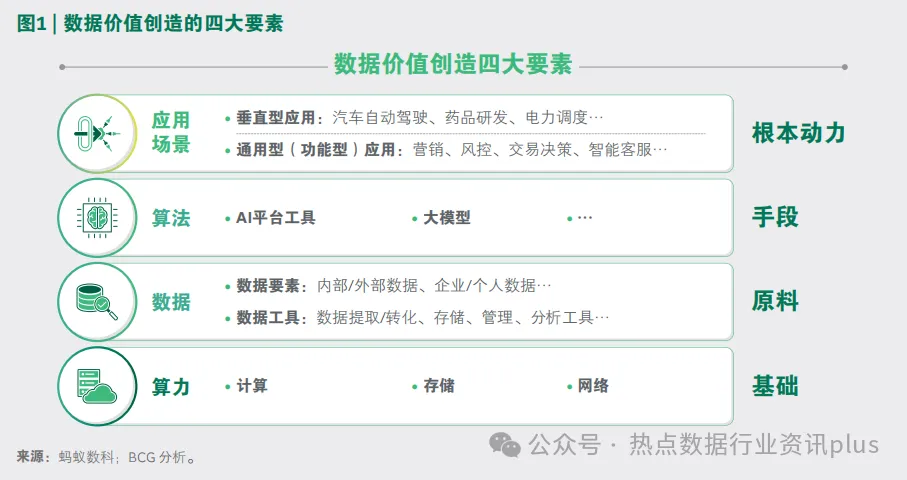
enterprises with four elements of data value creation have the ability to circulate data internally. However, due to the lack of certain elements, most enterprises need to exploit data value through external circulation.. Among the four elements required for data value creation, computing and algorithms can usually be obtained through external procurement, which in most cases does not hinder the creation of data value too much. Data Innovation application leaders, such as large Internet companies, can internally match data and application scenarios, and independently complete the entire data link closed loop, that is, data internal loop. However, in reality, the vast majority of enterprises have misplaced data and application scenarios, which require external information injection. Through cross-enterprise collaboration, data flow across subjects is closed-loop to generate greater data value. The enterprise's demand for external data or application scenarios promotes data circulation, forms external data circulation, and also promotes professional division of labor on the data value circulation link.
The data outer circulation market defined in this report includes both on-site "data element trading market and off-site? Direct or indirect forms of data value circulation and trading activities. In fact, at present, the vast majority of data value circulation activities in China take place outside the market.
1.2 What is data value network?
Data Value Network is a value network with data elements as transaction circulation objects, covering a series of value creation books from data generation to application (see figure 2). The value chain is the most basic path of value flow. According to the definition of the industry, the value chain is a one-way flow process of the value of goods and services between the factor supplier, the intermediate link and the demand side along with the business activities of the enterprise. A series of value chains form the value network. The value network is a multi-dimensional and three-dimensional network structure with a variety of link combinations. The value network, which takes data elements as circulation subjects, is called the data value network. Broadly speaking, the data value network shall cover all on-site and off-site, direct and indirect data value circulation activities (data itself, data products, and data services) generated between different enterprises in the data loop link, and the market of technical tools that support the circulation of data value.

Based on the division of labor in the industrial chain, we further subdivide the data value network into three market segments: data application services and data element circulation data basic tools (see figure 3). The data application service market converts data resources into valuable insights to help enterprises better grasp market trends and understand consumer preferences. The market size in 2022 is about 50 billion -100 billion RMB 4. Data elements circulation market aggregates scattered data, completes preliminary processing such as data cleaning, and then supplies it to the demand side to promote data transaction circulation. In 2022, the market size will be about 50 billion -100 billion RMB. The data basic tool market provides technical support to support the operation of the data value network. In 2022, the market size was about 60 billion RMB.
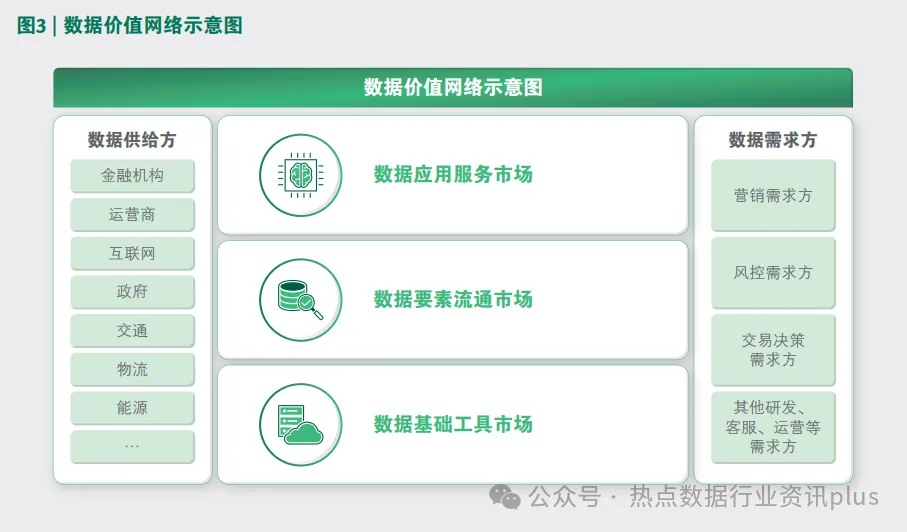
At present, most of the relevant market research reports adopt the narrow definition of data element circulation market, focusing only on various forms of data element circulation of on-site transactions, less discussion on over-the-counter data transactions, data application service market and data base tool market.
2. The market has formed a specialized division of labor of & ldquo; Four plus-& rdquo;
in the data loop link, the differences and comparative advantages of each enterprise's factor endowment determine the specialized division of labor in the market, forming five roles: demand side, supply side, circulation side, application service provider and infrastructure technology tool provider.(See figure 4). The demanders, suppliers, distributors and application service providers are the direct participants in the market. They build the main link nodes of data elements from supply to circulation applications and directly participate in the creation and circulation of data values. Meanwhile, to ensure the normal operation of the data value network, various professional technology providers have also emerged in the field of data infrastructure technology tools.. Although they do not directly participate in the creation and circulation of data value, they provide technical support for the entire network construction, which is the basis for data value creation and data value network operation.

The sustainable development of the data factor market has also promoted diversified business models. In addition to traditional data sales, there are currently four main types of models in the market:
transaction intermediary service mode. Players represented by the data exchange connect the data buyers and sellers and make profits through commission membership system, value-added transaction service 5 and other ways.
Data subscription mode. Players represented by data aggregators (such as enterprise search, Wande, etc.) aggregate and cleanse the data to form a preliminary data set, and then subscribe to it, the standardized data products are periodically sent to customers through offline data packets or real-time APIs, and the customers pay a fixed usage fee according to the specified cycle.
Data consulting service mode. Data service providers, represented by market research institutions and consulting companies, provide insights and suggestions to customers based on data analysis. In addition to reporting sales, data consulting services mostly adopt the project system, which is customized according to customer needs and charges customers according to project complexity and time limit requirements.
Data Insight, solutions, and platform service models. Players represented by application solution providers provide customers with comprehensive solutions for data marketing and risk control (such as anti-fraud rating, etc.), and aim at customers with different characteristics and based on different solutions, or charge for customized integration services, or charge for providing services in the form of SaaS based on the number of times of use, or charge for sharing the usage income.
2.1 four direct market participants: data demander, supplier, distributor and application service provider
2.1.1 The data demander is the value driving force
the commercial value generated on the demand side is the most important factor driving the circulation of data elements.. Downstream enterprises use data elements to achieve business results, which will promote more data demand, thus stimulating data circulation in the entire industrial chain.
Scenarios that are close to money, such as marketing, risk control, and transaction decision-making, take the lead in driving large-scale data circulation, which is currently the most important demand scenario with the largest market scale.
In terms of marketing, the brand side needs to extract valuable rules from the data, formulate more effective marketing strategies, increase product sales and realize commercial value.. For example, beauty brands find that a user often buys a certain type of products through data analysis, so they push the promotion information of this type of products to improve the product conversion rate. In 2022, the scale of China's digital marketing market was about 1 billion RMB.
In terms of risk control, financial enterprises need to use data to better identify, monitor and warn risks, reduce enterprise risks and improve business security.. For example, banks can understand customer transaction records and credit status through data, evaluate credit risks more accurately, and reduce non-performing loan ratio. The scale of China's risk control market in 2022 is about 33 billion RMB 6
in terms of transaction decision-making, financial enterprises use data to assist in decision-making and seize business opportunities. For example, securities companies predict future market trends by analyzing historical data and market trends to provide basis for transaction decisions.. In 2022, the scale of China's transaction decision-making market (such as financial databases and various transaction information databases) was about 12 billion RMB.
From an industry perspective, finance and the Internet are currently the two areas with the most obvious value for data commercialization, with the highest willingness to pay.. Scenarios widely used in the financial industry include risk management and compliance, investment transaction decision-making, and precision marketing. In the Internet industry, digital marketing is the most widely used.
2.1.2 The data supplier is the resource owner.
Suppliers provide necessary data resources for the market, and operators, the Internet, financial institutions and the government are the main suppliers. At present, the domestic market data supply mainly comes from three Convergence: The first is traffic convergence, such as the Internet and operators. The Internet and operators have accumulated a large number of users' basic information, network behavior habits, platform browsing records and channel sales data by virtue of their platform advantages. The second is capital convergence, such as finance and payment institutions. As the key node of transaction settlement, financial and payment institutions have accumulated a large number of enterprise and individual assets, credit records, credit conditions, etc. The third is the policy convergence in the process of managing or providing public services, various functional departments of the government have accumulated a large amount of enterprise industrial and commercial information, tax records, Social Security data, personal credit investigation and other national and industrial statistics, etc.
The supplier cashed through the sale of data and related services. Due to privacy compliance and security requirements, the market is still facing the problems of Data & ldquo; Difficult supply & rdquo;& ldquo; Difficult cashing & rdquo;. Taking the service of the operator as an example, the operator has accumulated a large amount of identity information, payment information, Internet access behavior and location data through the service support system (domain B) and the Operation Support System (domain O). Based on the requirements of the personal information protection law, operators need to take a series of security measures to ensure data security compliance, which makes data supply more difficult and the data transaction boundary is not completely clear, operators are cautious in data opening and currently only provide desensitized data packets or analysis results to the market. Although operators are willing to cash in data, they are also actively exploring cash-in methods such as data, scheme, platform, project system, etc. in the fields of banking, insurance risk control precision marketing, etc. However, in technology, challenges remain in terms of security and market mechanisms (see figure 5)
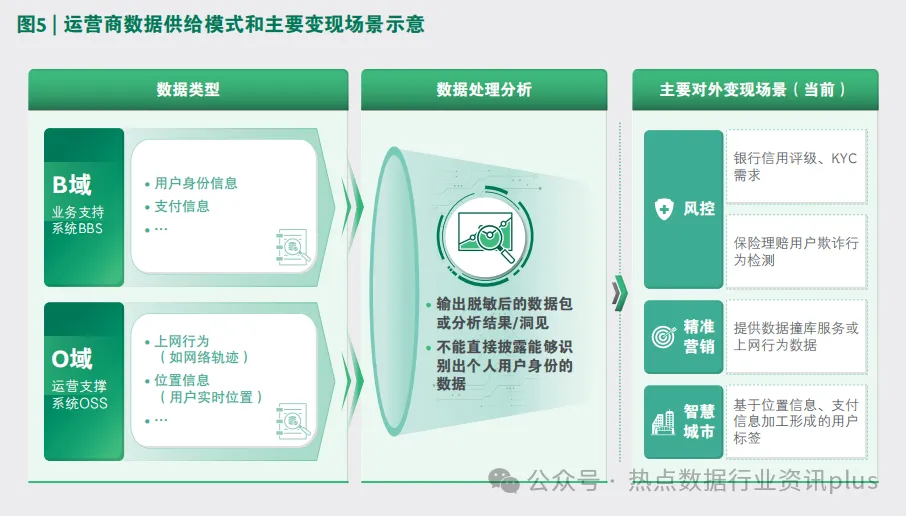
2.1.3 data flow provider promotes circulation efficiency
the data flow provider gathers a large amount of raw data and cleans it to form a standard data product supply market, which improves data circulation efficiency and accelerates the release of data element value. Data flow providers include three types of players: data case Partners, transaction service providers, and data processing and rough processing service providers.

2.1.4 data application service providers provide insight value
the application service provider owns the industry know-how, which deeply combines data with technologies and algorithms to explore the potential value behind data, meet customers' deep insight needs, and empower users' business.. Based on the products and services provided by application service providers, we divide them into application solution providers and data service providers. Application Solution providers include Internet service platforms, marketing solution providers (such as Alimama and Umeng), risk control solution providers (such as shield and Bairong), and credit investigation companies (such as Baixing and Pudao). Data service providers include market research institutions, system integrators, and customization developers.
Digital marketing is the main service scenario of Application Service Providers. With abundant traffic, data and technical resources, the head Internet service platform obtains the main value of the marketing market through advertising realization; marketing Solution Providers cooperate with head traffic providers to gain profits by providing marketing solutions.. The head Internet service platform has accumulated a large amount of online user behavior and transaction data during its operation. Based on these data, it has created personalized user portraits and recorded consumers' shopping behaviors and preferences. Brand merchants can use the huge user groups and consumer portraits of the Internet platform to place targeted advertisements on the platform to improve brand exposure, and the Internet platform charges a certain proportion of advertising fees as revenue. Marketing solution providers often have a solid cooperative relationship with the head traffic platform. They use the user behavior data accumulated by the platform and integrate the user search records of other sites (such as search engine companies), combine its own algorithms to form diversified solutions and benefit from providing marketing solutions to the brand side (see figure 6)

2.2 one technology authorizer: infrastructure technology tool provider
infrastructure technology providers mainly provide four types of technical tools to the market, including data extraction, transformation and management tools, data storage tools, data analysis tools, and data security tools.(See Figure 7).

Data storage tools: the basic carrier of data elements, the prerequisites for data management and analysis, the current market concentration is high, and the competitiveness of domestic manufacturers is gradually increasing. Product strength, open ecology and customer service are the key success factors. Database is currently the largest platform software product in the domestic market, with a market size of about 37 billion RMB. The market concentration is high and cloud vendors dominate, but independent distributed database vendors represented by OceamBase are growing faster. The localization of Xinchuang is the main trend. In non-core systems, centralized databases represented by Dameng have been more and more widely used, and distributed databases represented by OceanBase are being widely used in core systems. Facing the challenge of massive data, enterprises are building modern data architectures. Upgrading from centralized databases to distributed databases is becoming a new choice and trend. Data Warehouse Cloud and Lake warehouse integration are two main technological development directions.
Data analysis tool: 7 tools for data value creation. AI platform tool is one of the most important products, and the scale effect of the first business is obvious.. Product Matrix, technological advantages and ecosystem construction are the key success factors. AI platform tools are the most important data analysis products. At present, the domestic market size is about 12 billion RMB, and 30% of AI platform tools are Machine learning platforms. The technical threshold of machine learning platform is relatively high, the top five players account for nearly 70%, and the scale of head manufacturers continues to expand, thus the competitive advantage becomes more and more obvious. One-stop solution for deep integration of data and AI, achieving faster technological innovation with lower computing costs and building an ecosystem become key winning factors
data security tool: the fundamental guarantee of data value circulation, which runs through the entire data technology stack. There are many industry participants and no absolute leaders in the market. Complete security solutions are the key success factors. Data security includes data security compliance, database security, data desensitization, and privacy computing platforms. Compliance is the most important driving force for enterprises to build their data security capabilities. Data Classification and grading are the starting point for enterprises to carry out data security compliance governance. At present, the data security market has a scale of about 13 billion RMB (including products and services). The main players include three types: specialized data security manufacturers represented by Anhua gold and Quanzhi technology, comprehensive network security providers represented by Qianxin, as well as cloud providers such as Tencent and Alibaba Cloud. At present, various manufacturers provide ruoqian product module portfolio based on their own advantages, and there is no mature overall data security compliance solution.
3. Deduction of future market core trends
3.1 favorable policies come out frequently
in terms of policies, the government continues to encourage and support data value circulation, build more data hub Highlands, and promote more data opening. At the national level, policies and measures have been implemented one after another, the national data Bureau has been set up, the construction of data element market has been accelerated, local data exchanges, government big data platforms and other institutions have played an increasingly important role in the data value circulation network. At the local level, Beijing, Shanghai, Shenzhen and other places successively issued policy responses-Beijing issued "Implementation Opinions on better exerting the role of data elements and further accelerating the development of digital economy", shanghai released "action plan for promoting innovation and development of data elements based on new track of digital economy (2023-2025)", shenzhen formulates interim measures for the administration of data traders and third-party service agencies for data circulation transactions in Shenzhen-encourage government departments, public institutions, central State-owned enterprises and other suppliers holding huge amounts of data to actively promote the commercialization of data, clearly create a hub for data element allocation, and jointly promote the public data authorization operation to cultivate and develop the data value circulation market.
Data assets into the table, providing a basis for data transaction pricing, is a key step for data resources to move towards data asset. In August 2023, the Ministry of Finance formulated and issued the Interim Provisions on accounting treatment related to enterprise data resources. Many places have carried out the exploration of data entry into the table first, which provides the basis for the management and application of enterprise data assets, it is conducive to the transaction pricing of data assets in the future to further promote the development of the data demand market.
3.2 technological innovation promotes data value recognition
Technically, the implementation of generative AI has promoted the industry's recognition of data value.. The implementation of AI models makes enterprises realize that data will become an important starting point for Enterprise Development. For example, virtual assistants based on generative AI replace some manual online customer service to complete pre-sales consultation and after-sales management of regular, both help enterprises save costs. Chip manufacturers actively explore the combination of AI models and EDA tools to efficiently and automatically generate high-quality test cases in different forms and adapted to various verification environments, reduce some repetitive and complicated work in the chip design process, improve work efficiency, lower the research and development threshold, and solve the Talent Challenge. As a result, more enterprises are actively exploring the implementation and application of AI models in research and development, production, sales, service and other links, and their recognition of data value is continuously improving. Data is regarded as the core asset and key competitive advantage of enterprise development, and becomes an important basis for enterprise decision-making, market positioning and customer needs.
3.3 changes in supply and demand
3.3.1 demand side: new application scenarios emerge and data demand explodes
the wave of advanced technologies, such as AI models, has promoted the emergence of new data application scenarios on the demand side and the explosive growth of data demand. There are many application scenarios suitable for the implementation of generative AI in various industries (see Figure 8, for example:

pricing forecast for retail industry: AI big model algorithm will train and simulate based on historical sales data, product information and market trends to find out the rules behind the numbers. After the model is trained, price prediction results can be generated based on specific input parameters (such as seasons) to help retailers formulate more reasonable pricing strategies, improve profits and reduce the risk of inventory backlog.
Personalized services in the financial industry: AI financial assistant helps account managers better understand customer needs according to customer behavior and preference data, and sorts out existing financial products to form personalized product recommend suggestions. For example, the AI model organizes historical customer communication records, asset allocation, risk tolerance and other data, provides detailed customer portraits and risk assessments for customer managers, and according to customer needs, automatically generate personalized financial solutions and communication skills to expand the service boundaries of customer managers and improve service capabilities.
Precision medical treatment in the medical and health industry: AI model combines multi-source data such as gene data, clinical records and vital signs of patients to formulate personalized treatment plans according to patients' disease conditions and gene characteristics to improve the accuracy and effect of treatment.
The gradual implementation of these use cases leads to more data value circulation requirements. However, the increase in the training data level by the AI model itself will increase the data demand exponentially.
3.3.2 supply: more data is open or new data providers appear
the explosive growth of data demand drives demanders to actively seek new data supply. Driven by policy guidance and technological development, the market expects more data to open up and new data suppliers to appear.
First of all, as the digital level of the industry continues to improve, the effective supply of data continues to increase.. Take the automobile industry as an example. In the traditional automobile scenario, the data type is single, mainly based on the vehicle operation data such as engine speed and mileage. With the advancement of automobile intelligence and network connection, the types of industry data are increasingly diversified. New data include data collected by sensors such as millimeter radar wave, real-time communication data between vehicles and between vehicles and infrastructure through vehicle networking technology, user behavior data such as driver's driving habits and driving paths, and Internet data such as navigation planning, etc, the types of data available in the market are constantly enriched.
Secondly, data hub Highlands are forming under the policy. At present, detailed data infrastructure systems have been introduced in many places. Governments, leading enterprises, etc. are far ahead in terms of data magnitude and dimensions and are becoming important data hubs, it plays a key role in promoting the efficient use of data elements and is expected to further expand its influence in the future.
Based on the digital level of the industry and the degree of data concentration, a large number of new data suppliers are being born, such as energy, hospitals, transportation, automobiles, logistics, etc.(See Figure 9). Energy, hospitals and transportation industries are highly digitized. Leading Enterprise Industry associations gather a large amount of data and have potential for data supply. Driven by the development of new energy and logistics digitization, the automotive and logistics industries have rapidly improved their digitization level, and their accumulated data volume has increased significantly. The industry is also building data application scenarios and actively exploring ways of data realization. We expect that with the further clarification of downstream scenarios and the establishment of a data circulation compliance system, energy, hospitals, transportation, automobiles and logistics industries are expected to become new data suppliers.
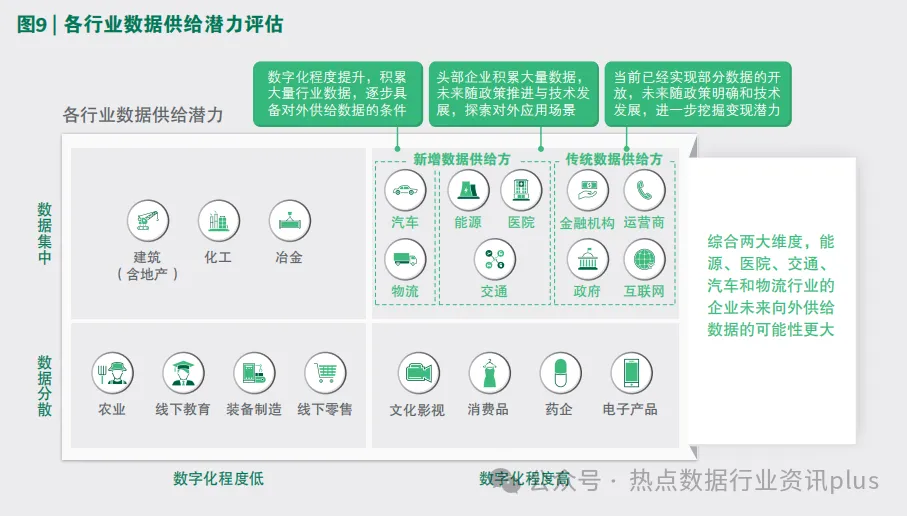
3.4 data value circulation link changes
the initial matching between data demand and supply forms the prototype of data circulation link. At present, the market has formed a number of data value circulation links combining demand side, supply side, circulation side and application service provider around three major scenarios: marketing, risk control and transaction decision-making. Technical tool providers provide technical support to assist in the efficient circulation and value release of data elements.
With the increasing demand for data realization, new data sources have emerged, some new data links have been built, some old data links have been reconstructed, and the data circulation link network has been further woven.. In the future data value network, new data suppliers will establish new channels. The changes in the division of labor in the data value chain, the replacement of government functions and the changes in downstream requirements have resulted in the reconstruction of the original data link. The increase of AI large model applications has also driven new external circulation paths (see Figure 10)

3.4.1 marketing scenarios
with the rise of new traffic platforms, brands need to closely combine their own and external data and use new technologies to formulate more effective marketing strategies, thus creating new data circulation paths. In the current marketing link, on the demand side, in order to increase customer acquisition rate and revenue, the brand side needs to adopt digital solutions to reach users more accurately, this requires comprehensive user data and market data as support. At present, the supply side mainly provides user behavior data by the Internet platform. The third-party marketing data service Association aggregates data through crawlers and other means to form standardized data products and sell them to downstream customers, or the Internet platform marketing solution provider converts the data into analytical insights, cash through advertising and marketing solutions. As the traffic pattern changes, the demand side pursues higher marketing efficiency. We expect two changes in the data flow path in the marketing scenario (see Figure 11):

3.4.2 Risk control scenario
To C risk control
with the implementation of credit investigation & ldquo; Disconnection & rdquo; Policies, more data sharing and cooperation scenarios have emerged. Enterprises need to use data and related technologies to improve risk control management and meet low-risk operation requirements, this affects the change of data circulation path.. In the current ToC risk control link, the financial industry is the main demand side, and credit risk control (including anti-fraud) is the main application scenario, which requires basic enterprise information, credit evaluation, default information and other auxiliary risk control management objectives. At present, the data supply of government and financial institution operators is relatively limited, and the industry is mainly based on credit data provided by Internet platforms. Institutions such as Jin Baoxin, the credit information center of the People's Bank of China, will aggregate and process the data. Meanwhile, solution providers such as tongdun and Bairong will conduct in-depth analysis of the data to form business solutions with business value. Risk control solution providers and financial institutions once had direct connection channels, but & ldquo; Disconnection & rdquo; After the policy was issued, this channel was cut off, and financial institutions must be connected through credit agencies in the future. With policy-driven and functional reinforcement of some links, we expect three changes To the data flow path in the C risk control scenario (see Figure 12 ) :

To B risk control
To B requires more comprehensive and accurate risk assessment. Enterprises need To use more dimensional data To support more complex application scenarios, thus driving the transformation of data flow paths.. In the current T B risk control scenario, the financial industry is the largest demand side, and credit risk control and transaction risk control are the most important application scenarios. Financial institutions and industry users need to integrate multiple types of data to conduct risk assessment for partners, including industrial and commercial, credit, tax data, trade payment information, etc. This information is currently mainly provided by government departments. Risk control data service providers, such as enterprise search, aggregate and cleanse data and then output data to downstream in the form of data subscription to earn data aggregation value. In the application and solution phase, risk control application solution providers such as tongdun and Bairong bring data into the risk control model for fine processing to earn data insight value. Due To changes in requirements and standardization of data applications, we expect two changes To the data flow path in the risk control field of To B in the future (see Figure 13 ):
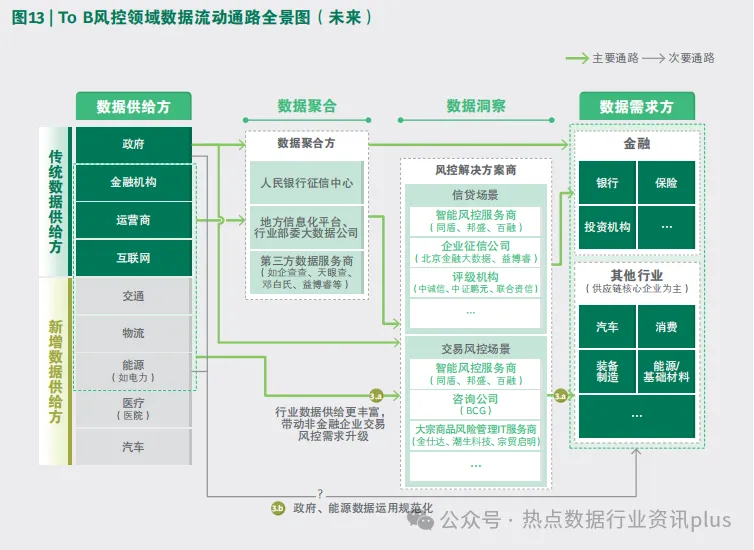
3.4.3 transaction decision scenarios
In the transaction decision-making scenario, there are already mature player card positions in the market, and there are limited opportunities for future data flow path reform. Currently, financial transactions and bulk transaction decisions are two mainstream application scenarios. The financial industry is the largest data demander. The data circulating in the market include macro-economy, market information, capacity supply and demand data, in stock futures price data, etc. At present, the supply of market data is diversified, mainly based on public information such as Internet media information, company annual reports, performance reports, industry analysis reports, etc. In the data aggregation phase, there are already mature leading enterprises (such as Wande and Zhuochuang) with card positions. Market research institutions such as research institutes and consulting firms will also provide customers with further insights based on data aggregation products. At present, the decision-making pattern of data transactions is relatively stable, there are already mature player cards in the market, and there are limited opportunities for future data flow path reform (see Figure 14).
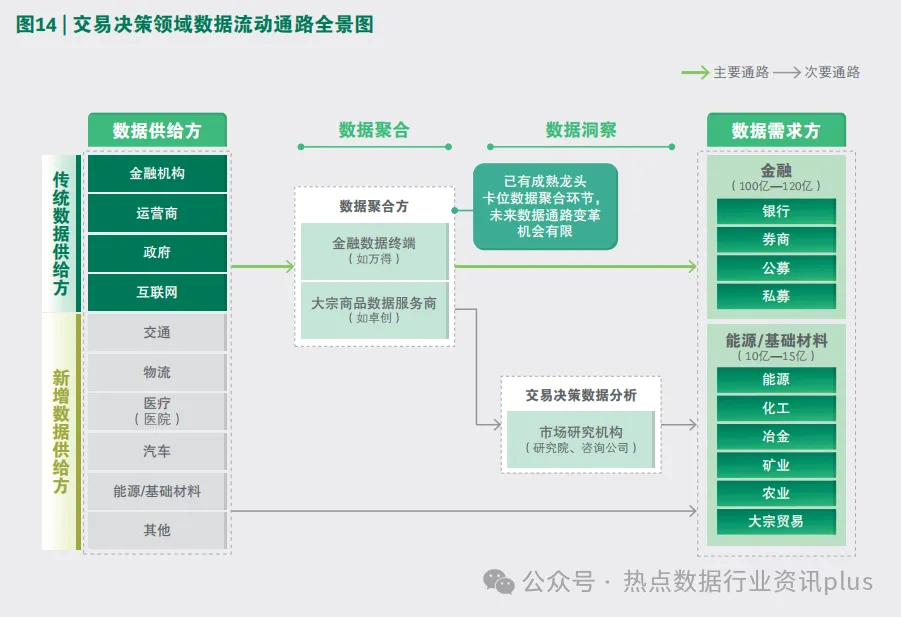
3.4.4 large model application
big models drive the generation of new use cases, and new use cases drive the emergence of new data sources and new data links. Driven by the application of large models, more applications are generated, such as intelligent chat robots. Intelligent chat robots are mainly used in marketing, transaction decision-making, and customer service scenarios. For current customer service scenarios where data is mainly circulated, the big model upgrades the existing data analysis methods, the man-machine copilot model is formed, thus a new path of outer circulation is built around the large model. We expect that the application of the large model will bring three changes to the data flow path (see Figure 15 ):

4. Current industry pain points
although data value is recognized by more and more enterprises, there are still three pain points in the change process of data value network pattern.
4.1 & ldquo; Dare not use & rdquo if you want to use it;
the purpose of privacy protection supervision is strict, and the supervision of data circulation is still continuously improving. Enterprises have concerns about compliance risks in the use of external data, which also affects data infrastructure tools, in particular, security technology and privacy protection put forward higher requirements.. High compliance risks and high security pressures are major challenges faced by enterprises. The Internet security law, data security law, personal information protection law and other relevant laws and regulations strictly stipulate the standardized use of data and the protection of security and privacy. If an enterprise violates relevant laws and regulations, will face more severe punishment. As the data transaction policy still needs to be further clarified, the relevant demonstration cases are still in the first exploration period, and the enterprises are not sure about the assessment of compliance risks, so there are many concerns about the implementation of the data circulation plan, do not dare to output to the outside easily. At the same time, increasingly strict data privacy regulations, data protection policies, and normative requirements for data exchange and sharing have also made enterprises pay more attention to their own data security and external data compliance. Data security and privacy protection technologies have become important bottlenecks in data circulation.
4.2 & ldquo; If you want to use it, you cannot use & rdquo;
the data supplier's own data governance level is insufficient and does not have the conditions to export high-quality data, which requires enterprises to have better data governance capabilities.. At present, data suppliers are mainly facing two problems. One is insufficient data governance capabilities. Some enterprises that have completed informatization do not pay enough attention to data governance, and there are many problems such as inconsistent data collection standards, missing data fields, and chaotic data storage, resulting in poor data quality, it is difficult to use. Second, data sharing is insufficient. Generally speaking, the government, public institutions, central State-owned enterprises and other data supply hubs hold a large amount of data resources, but the degree of openness and sharing is relatively low. There are also data barriers within enterprises, and the phenomenon of isolated islands between data is serious, which makes it difficult to bring big data advantages into play cooperatively.
4.3 & ldquo; If you want to use it, you will not use & rdquo;
insufficient data finishing technical capabilities, insufficient application capabilities, and insufficient value of a large amount of data, which puts forward higher requirements for data application tools. At present, a large amount of data is still on the surface of the demand side for industry statistics and market tracking. On the aggregation side, it is only simple rough processing services such as data cleaning, and the data deep mining technology tools are not perfect, there are few professional in-depth scenario analysis and data insight at the back end of the data link. For example, in the medical field, even if there is a large amount of patient data, if medical institutions cannot effectively use these data to diagnose diseases, formulate treatment plans and evaluate the treatment effect in a closed loop, then these data cannot give full play to their maximum value.
4. Main opportunities for future data value networks
based on the analysis of the trend and pain points of the data value circulation network, we find that the current links connecting a large number of data demands and supplies are not smooth, which hinders the full release of data value. In order to promote the development of data value network and ensure the effective establishment and smooth circulation of data links, the market should actively pay attention to new applications in the change of data supply and demand pattern, structural opportunities for new supply and upgrading opportunities for infrastructure technical tools.
5.1 New Applications
the upgrade of traditional application scenarios and the new scenarios brought by the development of big models have created hundreds of billions of data applications and solutions in the market.
5.1.1 opportunities in traditional scenarios such as marketing and risk control
opportunity 1: marketing opportunities under the new traffic pattern
new traffic parties (such as private domain traffic) generate new data and hope to transform the data into insights with business value, so as to reach target customers and form a marketing closed loop to realize data value release.. Referring to overseas experience, due to the lack of technical capabilities of new traffic providers, they often choose to cooperate with solution providers to integrate user data gathered on the platform, as well as various user behaviors and trajectory data purchased from external sites, gather to the solution CDP platform for data processing to form a user profile, and reach the target users through multiple channels through the solution provider platform to form a marketing closed loop. For solution providers, they can seek opportunities to cooperate with emerging traffic platforms to provide end-to-end full-link marketing services and explore data value.
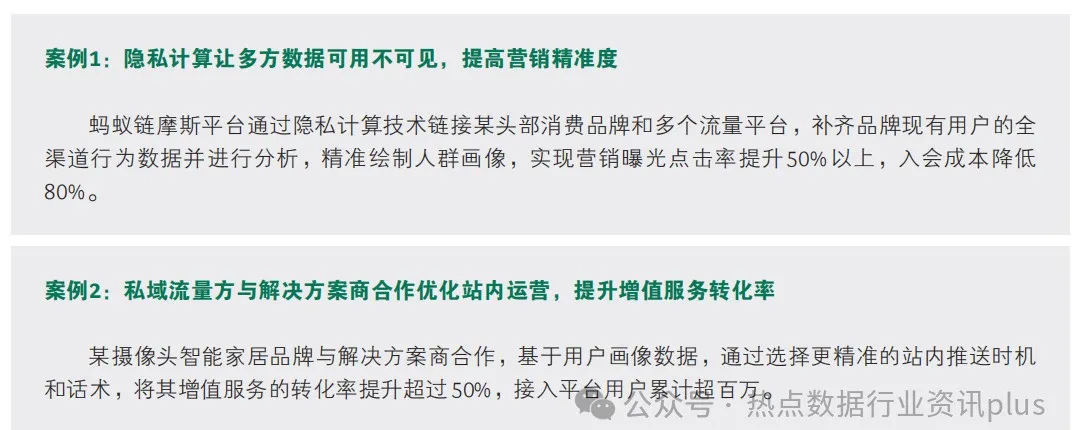

Opportunity 2: Risk Control solution opportunities
personal credit investigation & ldquo; Disconnection & rdquo; After the implementation of the policy, third-party personal credit investigation agencies have become a necessary channel, and the importance of credit investigation agencies has increased.. Due to the limited profits of basic credit reporting services, credit reporting agencies can enter into high-profit areas through product innovation and expansion to non-financial fields. Referring to overseas cases, personal credit agencies will also provide credit rating and decision support and other value-added services (such as analysis models, decision-making tools, software and systems, etc.), effectively meet the data analysis needs of financial institutions in the credit process. In addition, overseas credit agencies are actively completing industry kmow-how to help enterprises achieve efficient user management through more accurate user insights. It is difficult for Chinese third-party credit agencies to provide value-added services with high added value in the short term. Solution providers can cooperate with them to help individual credit agencies carry out projects as technology providers or consulting service providers.
As financial enterprises pay more attention to the effect and value of intelligent risk control solutions, non-financial enterprises continue to pay attention to real-time business risk monitoring and supplier credit risk management, the demand for intelligent risk control decision-making products and services is on the rise as a whole.. Solution providers can provide customers with risk control deep data insight services and innovative solutions based on multiple scenarios to meet their risk management and compliance requirements in diverse scenarios, to help enterprise customers deal with potential risks more accurately,
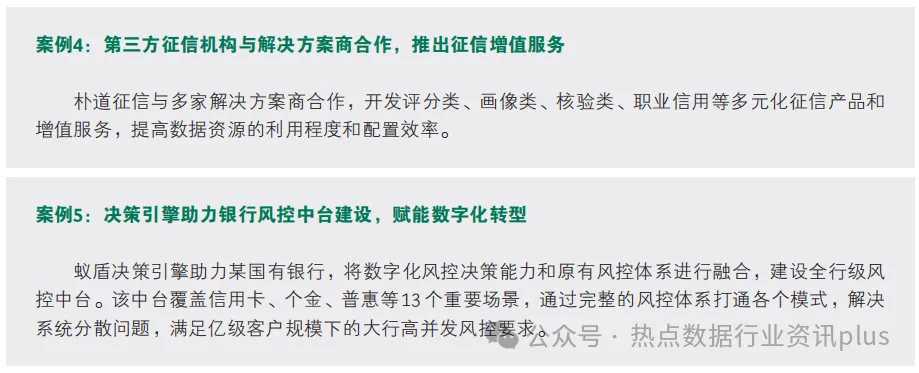
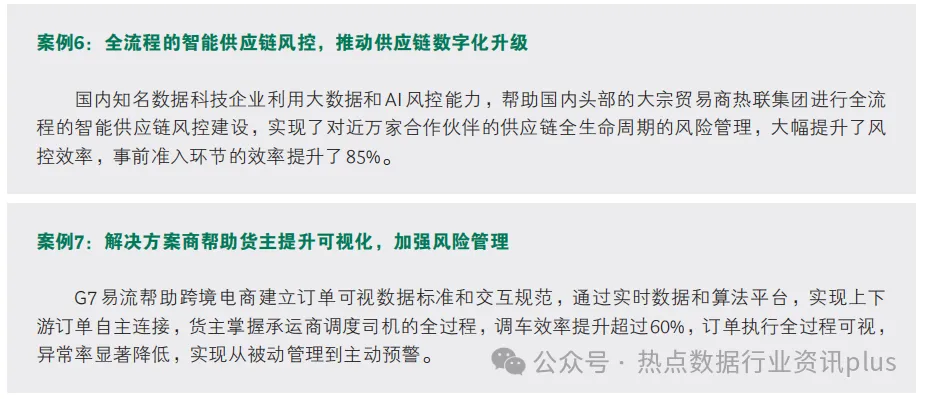
5.1.2 opportunities for new scenarios driven by big models
opportunity 3: General model
common models drive the generation of new use cases. These new use cases can help enterprises reduce costs or increase additional benefits, which not only creates AIMaaS & deg; platform product requirements, it also drives the demand for more model-driven data applications. New data applications based on big models are gradually launched, such as smart investment. Intelligent investment is mainly aimed at sales personnel and investment personnel of financial institutions. When investment personnel connect with investors, they can obtain professional investment suggestions from intelligent investment products by inputting the needs and problems of customers, grasp the needs of investors more accurately, improve professionalism and reduce labor costs. The overall investment of General big models is high, and close cooperation with cloud vendors is the key to long-term success.

Opportunity point 4: functional professional model
New data based on functional professional models, such as text and image, text and video, and code generation, which can help users improve efficiency and has been initially commercialized. At present, enterprises have many multi-modal requirements in specific professional fields, and there are window opportunities in the field of functional professional models.
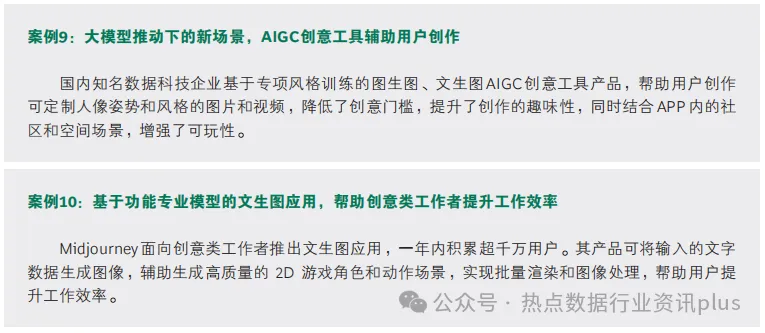
5.2 new supply
opportunity 5: open stock data to high-value scenarios
with the implementation of policies and the gradual availability of technical conditions, the government, public institutions, central State-owned enterprises and other data hub Highlands can realize more data compliance and apply it to high-value scenarios such as tens of billions of risk control and trillions of marketing.. To build a new supply-demand Link, a data hub needs two core capabilities: first, it needs to build a complete infrastructure to ensure data accuracy and availability. Secondly, we need to build appropriate data application products based on application scenarios to realize commercial value. Some data hub Highlands are actively cutting into high-value scenarios to accelerate data value release.

Opportunity 6: New data supply and productization
industries and companies with high degree of digitization and obvious data concentration effect supply more data products to the market to realize the realization of data value. Taking the power industry as an example, the current power grid enterprises form standardized products according to certain logic for data processing according to the scene, such as carbon emission monitoring data products, power city cockpit products, etc. At the same time, power grid enterprises are also actively participating in on-site transactions. In May 2023, China Southern Power Grid Guizhou Power Grid Corporation and Zhongding credit rating service Co., Ltd. completed the first in-session transaction in Guiyang Big Data Exchange. China Southern Power Grid provided data products for analyzing the electricity consumption behavior of enterprises, this includes the electricity consumption information of the required enterprise in the past three years, and assists the organization in enterprise rating.
5.2 new infrastructure
five trends in data application areas promote innovation in data infrastructure tools, and create three market opportunities: data security, AI Imfra, and data governance platform.. Complete data infrastructure is the foundation and key to the smooth circulation of data value. The more perfect and advanced data technology tools are, the higher the quality of data supply and safe and compliant transmission can be ensured, thus ensuring the continuous establishment and reliable operation of data links. In the future, driven by the five major data application trends, the data infrastructure technology tool market will become more and more important. Among them, data security technologies with strong customer demand and relatively competitive barriers, AI infrastructure and data governance platforms are major market opportunities (see Figure 16)

5.3.1 Data security
opportunity 7: data security products
data security is the basis for stable and efficient circulation of data value networks. Customers have strong needs, high barriers to competition, and obvious network effects.. Data security compliance (including data classification and classification) is currently the biggest driving force for enterprises to carry out data security Construction. Customers are in strong demand and are expected to maintain a high growth rate of more than 60% in the next two years, it is the track with the largest incremental contribution in the future in the entire data security market. Security products must have core technologies such as Privacy Computing and secure encryption, with high barriers to competition and obvious network effects.

5.3.2 AI Infra
opportunity 8: AI platform
AI platform plays the role of & ldquo; Bridge & rdquo; Between computing power and application, and has entered the fast lane of development. The rigid demand attribute is gradually strengthened, and the competition is booming.. AI applications are widely embedded in business processes, and its value is recognized by the market. The demand for AI platforms is gradually increasing, and the rigid demand attribute is increasingly obvious. The market size of AI platforms is expected to exceed 50 billion RMB in 2027. The track has high barriers to competition and requires profound technical reserves and experience. At present, the market is relatively scattered, and head enterprises are easy to form the following three advantages: first, they have a relatively rich product matrix, especially & ldquo; One-stop & rdquo; Solutions for deep integration of data and AI: second, strong technological innovation capability: Third, establish a sound ecosystem, create solutions with partners, and ensure business expansion.

Opportunity 9: AI data tagging
AI data tagging is an essential part of big chess data preparation, with strong market demand and high competition barriers.. Under the tide of big models, more and more emphasis is placed on the importance of high-quality labeled data to improve the model effect. There is a need in the market, and the market size is expected to reach 12 billion RMB in 2025. As data tagging manufacturers seek intelligent transformation and use AI to feed back data tagging to reduce their dependence on manpower, the competition barriers for AI data tagging are further improved. As a labor-intensive industry, the Core of Data tagging is to control costs while pursuing the ultimate quality and efficiency.
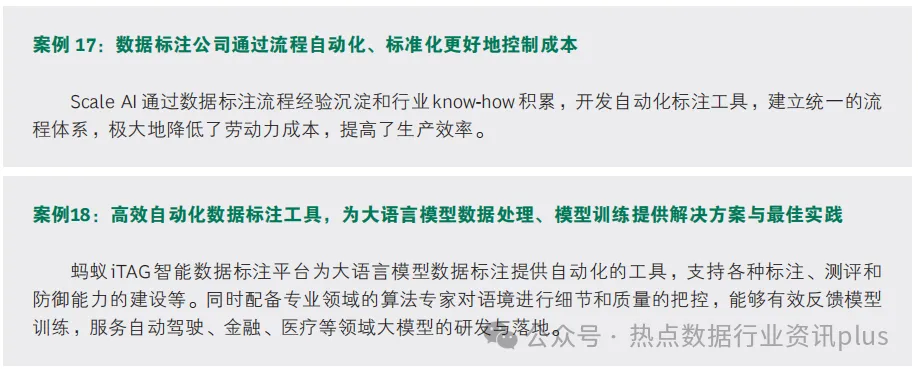
5.3.3 data governance
opportunity 10: Data governance tools
data governance is a key means for enterprises to achieve efficient data utilization and reduce metadata. Market demand will continue to be released. Data governance is currently in the demand transmission stage, and we expect four changes in the market in the future: first, with the help of policies and technological dividends, more customers in more industries (a large number of central enterprises, state-owned enterprises) will actively participate in it. Second, in terms of demand, data governance will change from internal self-use to application scenario-driven. Cross-industry applicable data governance services will become an important link. Third, in terms of technology, with the help of artificial intelligence, RPA and other technical means, the level of automation and intelligence will be greatly improved, realizing & ldquo; Autonomy and self-Evolution & rdquo;, federated learning 1 technology will make data available but invisible, connecting and cooperating. Fourthly, in the aspect of ecology, under the traction of industry data governance system and standards, the industry's big factories take the lead, and different types of players work together to promote the efficient circulation and application of data.
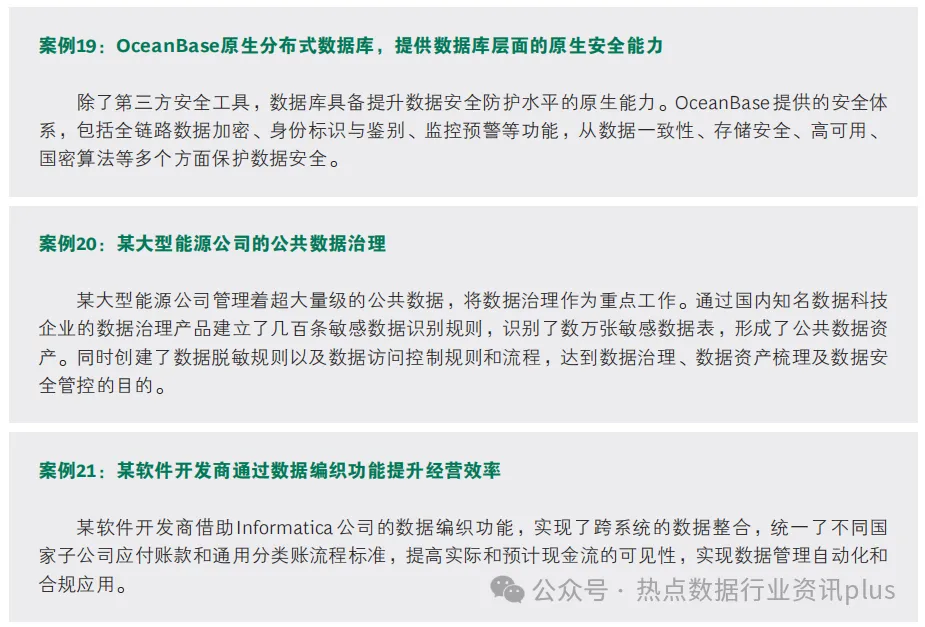
Conclusion
large-scale data interaction has formed a complex data value network. The continuous progress and innovation of technology have opened up more possibilities for data value creation, especially the application of AI big models and other technologies, greatly improves the depth and accuracy of data mining and insight. Through data-driven decision-making and innovation, enterprises can better understand market demand, optimize operation and even create a brand-new business model. The value of data is not only reflected in finance, consumption and other fields, but also plays an important role in health care, urban planning, environmental protection and other fields, bringing extensive welfare to the society. However, data value creation is not easy. We need to work together from the perspectives of system, process, technology, ecology, etc. to improve the productivity of digital value creation and jointly build a new data value Network World. In this digital era, we should meet the challenges and opportunities of data with a more open mind and jointly build a future for data to create value.
Article Source: Hot data industry information PLUS public number Hot inquiry point data industry information Pl


 Reprint
Reprint 